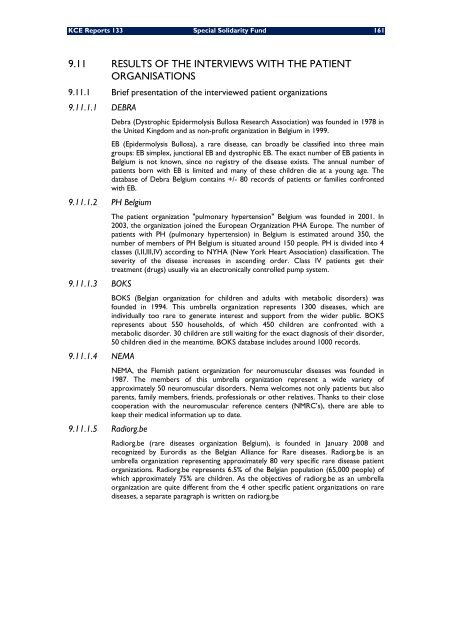Optimalisatie van de werkingsprocessen van het Bijzonder ... - KCE
Optimalisatie van de werkingsprocessen van het Bijzonder ... - KCE
Optimalisatie van de werkingsprocessen van het Bijzonder ... - KCE
You also want an ePaper? Increase the reach of your titles
YUMPU automatically turns print PDFs into web optimized ePapers that Google loves.
<strong>KCE</strong> Reports 133 Special Solidarity Fund 161<br />
9.11 RESULTS OF THE INTERVIEWS WITH THE PATIENT<br />
ORGANISATIONS<br />
9.11.1 Brief presentation of the interviewed patient organizations<br />
9.11.1.1 DEBRA<br />
Debra (Dystrophic Epi<strong>de</strong>rmolysis Bullosa Research Association) was foun<strong>de</strong>d in 1978 in<br />
the United Kingdom and as non-profit organization in Belgium in 1999.<br />
EB (Epi<strong>de</strong>rmolysis Bullosa), a rare disease, can broadly be classified into three main<br />
groups: EB simplex, junctional EB and dystrophic EB. The exact number of EB patients in<br />
Belgium is not known, since no registry of the disease exists. The annual number of<br />
patients born with EB is limited and many of these children die at a young age. The<br />
database of Debra Belgium contains +/- 80 records of patients or families confronted<br />
with EB.<br />
9.11.1.2 PH Belgium<br />
The patient organization "pulmonary hypertension" Belgium was foun<strong>de</strong>d in 2001. In<br />
2003, the organization joined the European Organization PHA Europe. The number of<br />
patients with PH (pulmonary hypertension) in Belgium is estimated around 350, the<br />
number of members of PH Belgium is situated around 150 people. PH is divi<strong>de</strong>d into 4<br />
classes (I,II,III,IV) according to NYHA (New York Heart Association) classification. The<br />
severity of the disease increases in ascending or<strong>de</strong>r. Class IV patients get their<br />
treatment (drugs) usually via an electronically controlled pump system.<br />
9.11.1.3 BOKS<br />
BOKS (Belgian organization for children and adults with metabolic disor<strong>de</strong>rs) was<br />
foun<strong>de</strong>d in 1994. This umbrella organization represents 1300 diseases, which are<br />
individually too rare to generate interest and support from the wi<strong>de</strong>r public. BOKS<br />
represents about 550 households, of which 450 children are confronted with a<br />
metabolic disor<strong>de</strong>r. 30 children are still waiting for the exact diagnosis of their disor<strong>de</strong>r,<br />
50 children died in the meantime. BOKS database inclu<strong>de</strong>s around 1000 records.<br />
9.11.1.4 NEMA<br />
NEMA, the Flemish patient organization for neuromuscular diseases was foun<strong>de</strong>d in<br />
1987. The members of this umbrella organization represent a wi<strong>de</strong> variety of<br />
approximately 50 neuromuscular disor<strong>de</strong>rs. Nema welcomes not only patients but also<br />
parents, family members, friends, professionals or other relatives. Thanks to their close<br />
cooperation with the neuromuscular reference centers (NMRC’s), there are able to<br />
keep their medical information up to date.<br />
9.11.1.5 Radiorg.be<br />
Radiorg.be (rare diseases organization Belgium), is foun<strong>de</strong>d in January 2008 and<br />
recognized by Eurordis as the Belgian Alliance for Rare diseases. Radiorg.be is an<br />
umbrella organization representing approximately 80 very specific rare disease patient<br />
organizations. Radiorg.be represents 6.5% of the Belgian population (65,000 people) of<br />
which approximately 75% are children. As the objectives of radiorg.be as an umbrella<br />
organization are quite different from the 4 other specific patient organizations on rare<br />
diseases, a separate paragraph is written on radiorg.be

















